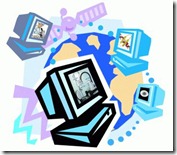 Profits are built on productivity, and today productivity is often improved by supporting a mobile workforce. There are very few businesses operating on a strictly 9:00 to 5:00 basis these days, and to save commuting time and promote productivity, a number of businesses are going mobile – allowing employees remote computer access to business data. Enabling a secure mobile workforce is a complex topic with many facets, so let’s start with the basics based on our experience.
Profits are built on productivity, and today productivity is often improved by supporting a mobile workforce. There are very few businesses operating on a strictly 9:00 to 5:00 basis these days, and to save commuting time and promote productivity, a number of businesses are going mobile – allowing employees remote computer access to business data. Enabling a secure mobile workforce is a complex topic with many facets, so let’s start with the basics based on our experience.
As with most businesses, we have been experiencing our own growing pains and have been adding staff and infrastructure to accommodate growth, including new furniture, a new copier, and new computer equipment. As a consulting firm, we also have a number of employees working in the field on a daily basis, visiting clients and supporting them with on-site services. And many of us have busy families, so it helps to be able to work from home. It was time to truly enable our mobile workforce.
We determined that the real key to a successful mobile workforce was remote access to business-critical data. Most of our employees have Internet access from home, and they can access the Web from client sites. So rather than trying to synch their laptop every time they hit the road or rely on passing files around via email, it’s easier to provide a central data repository to store client and operational files. That way employees can access whatever they need when they need it, and they always have access to the most current files.
There are any number of strategies you can use to centralize your business data. A number of start-ups use tools like Google Docs because of cost and convenience, since Google Docs is pretty much available from any type of computer. For Apple users, there’s also iWork, and for Microsoft users there’s Office Live. However, while these solutions let you centralize files, it still means you need a computer with the appropriate programs to access them. We prefer using a terminal server approach, and have standardized our office on Microsoft Terminal Services.
With a terminal server you can get remote access to applications, data, email, printers, just about anything on the corporate network. For us, it means employees can work from anywhere, on any machine with secure web access, either inside the office or outside the office. Each user gets his or her own personalized desktop that follows them to any workstation they choose to use.
We have seen a number of benefits from migrating to a terminal server approach:
– Easy access to business critical information, including client files, email history, etc. Employees don’t have to lug their laptops. They just need access to a computer.
– More productivity. Our salespeople, accountants, and consultants can spend more time working with clients. By reducing commuting and travel time we can service 30 percent more clients with our existing staff.
– Better use of office space. We have only one quarter of our team in the office at any given time, so we now have shared workspaces; a concept we could not initiate without shared computers.
– Reduced IT workload and costs. Centralizing applications makes it easier to manage a single location instead of multiple desktops, which gives our IT staff more time to work with clients. And we save money on hardware since we can use older desktop workstations and laptops.
– Better security. Centralizing files makes it easier to secure them with regular backups, and we don’t have to worry about sensitive data stored on laptops that can be lost or stolen.
We’ve carried the terminal server strategy to a number of clients as well. We find it works particularly well in locations where office workers tend to move around, such as doctors’ offices. The light bulb usually goes on when people see the technology in action. They see that the platform doesn’t matter, but the power is in improving productivity through mobile access.

